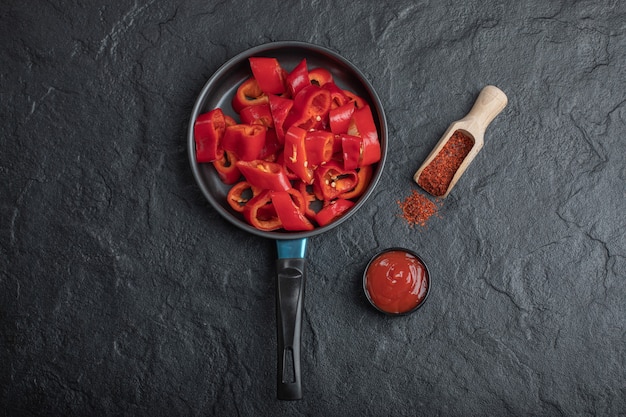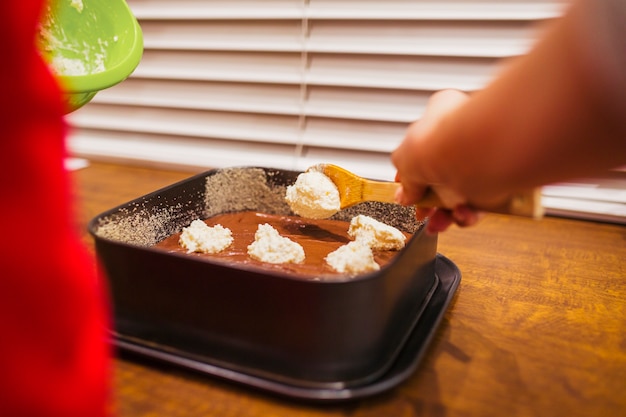I'm a huge fan of chili. It's one of those comfort foods that warms you from the inside out. But, I'll admit, I've been frustrated by the inconsistent advice out there about how long to cook chili in a slow cooker. Some recipes say 4 hours, others say 8, and some even go for 10! It can be really confusing, especially when you're eager to get that delicious, hearty meal on the table.
So, I decided to do some serious research and put together a comprehensive guide to help you figure out the perfect cooking time for your slow cooker chili. This isn't just about throwing a bunch of ingredients into the pot and hoping for the best. We're going to delve into the science behind slow cooking, explore different types of slow cookers, and consider the impact of various ingredients on the final result.
Get ready to become a chili-cooking pro! This guide will help you avoid overcooked, mushy chili and ensure you end up with a perfectly tender, flavorful masterpiece. Let's dive in!
(Part 1) Understanding the Science of Slow Cooking

Before we get into specific timings, it's important to understand the basic principles of slow cooking. It's all about using low heat over an extended period to break down tough cuts of meat, tenderize vegetables, and develop rich, complex flavors. This process relies on the magic of heat and time working in harmony.
How Heat Affects Chili
The low heat of a slow cooker gently melts fat from meat, creating a rich and flavorful sauce. It's like a slow, gentle massage for the meat, coaxing out its natural juices and oils. This process also breaks down collagen, a tough protein found in meat, transforming it into gelatin. This gelatin is the secret ingredient that gives your chili that silky, smooth texture, making it incredibly satisfying to eat.
The Power of Time
Time is a powerful tool in slow cooking. As you cook your chili, the heat gradually breaks down the proteins in the meat and vegetables, releasing their flavors and creating a symphony of aromas that will make your mouth water. Imagine it like a slow-burning fire, building a delicious depth of flavor over time. The longer you cook, the more tender the meat becomes and the deeper the flavors develop. It's like watching a delicious transformation unfold right before your eyes.
(Part 2) Slow Cooker Types: A Quick Overview

Now, let's talk about the tools of the trade. There are different types of slow cookers, each with its own nuances that can influence cooking times.
- Traditional crock pots: These are the classic slow cookers, the ones that have been around for ages. They typically have a low, medium, and high setting, and are ideal for long cooking times. Think of them as the reliable workhorses of the kitchen, always there for those long, slow cooks.
- Multi-Cookers: These versatile appliances are the modern marvels of the kitchen, often offering multiple cooking functions, including slow cooking. They can offer more precise temperature control and may have a “keep warm” setting, so your chili stays piping hot even after it's done cooking. Imagine them as the Swiss Army knives of cooking!
- instant pot: While technically a pressure cooker, the Instant Pot has a slow cook function too. This can be a great option for those who want the flexibility of both pressure and slow cooking, so you can switch between fast and slow cooking depending on your needs. It's like having two appliances in one!
Choosing the Right Cooker
The type of slow cooker you have will influence the cooking time for your chili. If you're using a traditional crock pot with only a low setting, you'll need more time than if you're using a multi-cooker with adjustable temperatures. For example, a traditional crock pot might need 6-8 hours on low, while a multi-cooker might achieve the same result in 4-6 hours. Always refer to the manufacturer's instructions for your specific model, as each appliance can have its own unique quirks.
(Part 3) Understanding the Impact of Ingredients

Just like different types of slow cookers, various ingredients can affect the cooking time for your chili. Here's a breakdown of some key considerations:
Meat Matters
The type of meat you use will directly impact how long your chili needs to cook. For example, leaner cuts of meat, like sirloin or tenderloin, will cook faster than tougher cuts like chuck roast or brisket. These tougher cuts benefit from a longer cooking time to break down their fibers and achieve tender results. Think of it like this: lean cuts are like a quick workout, while tougher cuts need a more intense, longer session to reach their full potential.
Vegetable Variety
The size and type of vegetables in your chili also play a role. Smaller vegetables, like chopped onions and bell peppers, will cook more quickly than larger vegetables, like potatoes or whole tomatoes. Similarly, harder vegetables, like carrots and potatoes, will need more time than softer vegetables, like zucchini or peppers. It's all about finding the right balance to ensure every ingredient is cooked to perfection.
Spice Level
The level of spice in your chili can influence cooking time. If you're using a lot of chili powder or cayenne pepper, you might want to shorten the cooking time slightly to avoid overcooking the spices and making your chili overly bitter. Remember, a little spice goes a long way, so be mindful of your spice levels and adjust the cooking time accordingly.
(Part 4) The Perfect Chili Timetable
Now that we've explored the factors affecting cooking time, let's get down to the nitty-gritty. Here's a general timetable for cooking chili in a slow cooker, taking into account the information we've discussed:
Traditional Crock Pot:
| Type of Meat | Low Setting | High Setting |
|---|---|---|
| Lean Beef, Pork, or Chicken | 6-8 Hours | 4-6 Hours |
| Tougher Cuts of Beef (Chuck Roast, Brisket) | 8-10 Hours | 6-8 Hours |
Multi-Cooker:
| Type of Meat | Low Setting | High Setting |
|---|---|---|
| Lean Beef, Pork, or Chicken | 4-6 Hours | 2-4 Hours |
| Tougher Cuts of Beef (Chuck Roast, Brisket) | 6-8 Hours | 4-6 Hours |
Instant Pot:
For slow cooking in an Instant Pot, follow the manufacturer's instructions. The times will vary depending on the specific model and the desired level of tenderness.
(Part 5) Tips for Perfect Chili
Here are some tips to ensure your chili turns out fantastic, no matter the cooking time:
Start with a Browned Base
For extra flavor and a richer sauce, brown your meat in a skillet before adding it to the slow cooker. This is like giving your chili a head start on deliciousness. Browning the meat develops a beautiful crust and releases those flavorful juices that will transform your chili into a symphony of aromas. It's a simple step that makes a big difference in the final result.
Don't Overcrowd the Cooker
Make sure you don't overcrowd the slow cooker. This can inhibit proper heat distribution and prevent the chili from cooking evenly. Imagine it like a crowded party - everyone needs space to move around and mingle! If necessary, split the ingredients between two slow cookers, or cook in batches. This will ensure that your chili cooks perfectly, every time.
Stir It Up
While the slow cooker does its magic, remember to stir your chili every few hours. This ensures the ingredients are evenly heated and prevents them from sticking to the bottom of the pot. It's like giving your chili a little dance break, keeping everything moving and mixing for a perfectly smooth and flavorful result.
Taste and Adjust
As your chili cooks, don't be afraid to taste it and make adjustments. You can add more liquid if it's too thick, or simmer it longer if you want a deeper flavor. Remember, cooking is a journey, not a destination. Embrace the flexibility of adjusting the recipe based on your taste preferences and the results of the cooking process.
(Part 6) Beyond the Basics: Exploring Different Chili Styles
While the classic slow-cooked chili is a staple, there's a whole world of chili styles to explore. Here are a few examples:
Texas Chili:
This chili is known for its thick, meaty texture and often uses ground beef as the primary meat. It typically includes chili powder, cumin, and other spices, and often includes beans. Imagine a chili that's bold and hearty, perfect for a cold winter day. It's like a taste of the American West, full of flavor and character.
Cincinnati Chili:
This chili is unique for its sweet and spicy flavor profile, often incorporating cinnamon, chocolate, and a touch of Worcestershire sauce. It's typically served over spaghetti with shredded cheddar cheese. It's a surprising twist on the traditional chili, offering a balance of sweet, spicy, and savory flavors. It's like a culinary adventure, taking you on a journey of taste and textures.
White Chili:
This chili features white beans, chicken or pork, and a creamy, often spicy sauce. It often includes ingredients like cumin, garlic, and jalape??os. Imagine a chili that's creamy and comforting, perfect for a light and flavorful meal. It's a lighter take on the classic chili, with a touch of spice and a creamy texture that's sure to please.
The beauty of chili is its versatility! You can customize it to your taste preferences and dietary restrictions. So experiment, try different flavors, and have fun with it! It's like having a blank canvas, ready to be transformed into your own culinary masterpiece.
(Part 7) Chili Companions: Perfect Pairings
Now that you've created your perfect chili, let's talk about the delicious accompaniments that can elevate your meal. These pairings complement the chili's flavors and textures, creating a satisfying and complete dining experience.
Sides that Shine
Consider these side dishes to enhance your chili:
- Cornbread: A classic pairing, cornbread adds a touch of sweetness and crumbly texture to counterbalance the chili's richness. It's like the perfect dance partner, complementing the chili's boldness with a touch of sweetness and a satisfying crunch.
- Rice: A simple yet satisfying accompaniment, rice provides a neutral base for the chili's flavors to shine. It's like a clean canvas, allowing the chili's flavors to take center stage and express themselves fully.
- potato salad: A creamy and tangy counterpoint, potato salad brings a refreshing contrast to the hearty chili. It's like a breath of fresh air, adding a touch of coolness and creaminess to the chili's warmth and richness.
- Cole Slaw: Crisp and refreshing, coleslaw adds a vibrant touch of flavor and texture to your chili. It's like a burst of color and energy, adding a refreshing crunch and a touch of tanginess to the chili's hearty flavors.
Toppings to Take It Over the Top
Finish off your chili with these delicious toppings:
- Shredded Cheese: Cheddar, Monterey Jack, or Colby Jack all add a creamy and flavorful topping. It's like a warm hug for your taste buds, adding a layer of creaminess and richness that complements the chili's bold flavors.
- Sour Cream or Yogurt: These add a tangy and creamy element to the chili. It's like a touch of sunshine, adding a bright and tangy note to the chili's warmth and richness.
- Chopped Onions: Add a bit of crunch and sharpness to the chili. It's like a burst of energy, adding a fresh and lively touch to the chili's hearty flavors.
- Fresh Cilantro: A touch of fresh cilantro adds a bright and herbaceous flavor. It's like a sprinkle of magic, adding a fresh and aromatic touch that elevates the chili's taste and aroma.
(Part 8) Chili Leftovers: Don't Waste the Goodness!
One of the best things about chili is that it gets even better with time. The flavors meld and deepen, creating a truly satisfying meal. Here's how to make the most of your chili leftovers:
Storage Solutions
Store your leftover chili in an airtight container in the refrigerator for up to 4 days. If you want to freeze it, transfer it to a freezer-safe container and freeze for up to 3 months. This will allow you to enjoy the deliciousness of your chili for days or even weeks to come.
Reheating Tips
When you're ready to enjoy your chili leftovers, you can reheat them on the stovetop, in the microwave, or even back in the slow cooker. Just be sure to heat them through thoroughly, and enjoy! It's like reliving the magic of the first taste, with a touch of nostalgia and the comfort of familiar flavors.
Leftover Chili Transformations
Here are a few ways to repurpose your leftover chili for a new meal:
- Chili Dogs: Top hot dogs with your chili for a quick and satisfying meal. It's like a classic comfort food with a twist, a delicious combination of two favorites.
- Chili Mac: Add your chili to cooked macaroni for a hearty and comforting pasta dish. It's like a warm hug in a bowl, combining the heartiness of chili with the comfort of pasta.
- Chili Nachos: Spoon your chili onto tortilla chips, add toppings, and enjoy a fun and casual snack or meal. It's like a fiesta of flavors, a combination of chili's warmth and richness with the crunch of tortilla chips and the excitement of toppings.
FAQs
Here are some frequently asked questions about slow cooker chili:
Q1: Can I add beans to my chili at the beginning or the end of cooking?
It's generally best to add beans towards the end of the cooking process. This helps prevent them from becoming mushy and ensures they retain their shape and texture. If you add them too early, they can absorb too much liquid and make your chili watery. It's like giving the beans a little space to shine, preventing them from becoming too soft and soggy.
Q2: How can I make sure my chili isn't too watery?
To prevent a watery chili, start with a smaller amount of liquid than you think you'll need. You can always add more as needed. Also, be sure to brown your meat before adding it to the slow cooker, and use a combination of diced tomatoes and tomato sauce to thicken the chili. It's like balancing the flavors and textures, ensuring a perfectly thick and flavorful chili.
Q3: Can I use a slow cooker liner?
Slow cooker liners can be a convenient option for easy cleanup, but they can also affect cooking times. Be sure to check the manufacturer's instructions for your specific liner, as some may recommend adjusting cooking times. It's like finding the right fit for your slow cooker, ensuring everything cooks perfectly and effortlessly.
Q4: Is it safe to leave chili in the slow cooker overnight?
It's not recommended to leave chili in the slow cooker overnight. The bacteria in the chili can multiply rapidly at room temperature, potentially leading to food poisoning. It's best to transfer the chili to the refrigerator after cooking to ensure its safety. Remember, food safety is crucial, and storing chili properly is essential to avoid any unwanted surprises.
Q5: What if my chili is too thick?
If your chili is too thick, you can thin it out by adding more liquid, such as broth, tomato juice, or water. You can also use a whisk to blend the chili and break up any clumps. It's like adjusting the consistency to perfection, ensuring a smooth and flavorful chili that's just right for your taste buds.
There you have it! Your comprehensive guide to slow cooker chili, from understanding the science to conquering the perfect cooking time. Now you're ready to create your own delicious and comforting chili masterpiece. Experiment, get creative, and enjoy the journey! It's a journey of flavors and aromas, a culinary adventure waiting to be discovered. So, grab your slow cooker, gather your ingredients, and let the magic of chili unfold!
Everyone is watching

Corn on the Cob: The Ultimate Guide to Perfectly Cooked Ears
Healthy MealsAh, corn on the cob. Just the name evokes images of sunny days, barbecues, and that sweet, juicy flavour that ...

Perfect Pork Roast Oven Cooking Time: A Guide to Delicious Results
Healthy MealsThere's something truly satisfying about a perfectly roasted pork. The aroma alone is enough to make your mout...

Ham Cooking Time: How Long to Bake, Smoke, or Boil a Delicious Ham
Healthy MealsAh, ham. It's a classic, isn't it? A real crowd-pleaser, especially around holidays. And when done right, it'...

Scallops: The Ultimate Guide to Perfect Cooking
Healthy MealsAh, scallops. Those delicate, sweet, and utterly delicious morsels of the sea. They hold a special place in my...

Spaghetti Squash: The Ultimate Guide to Cooking and Serving
Healthy MealsRemember that time you saw spaghetti squash at the supermarket, looking all bumpy and strange, and thought, "W...
